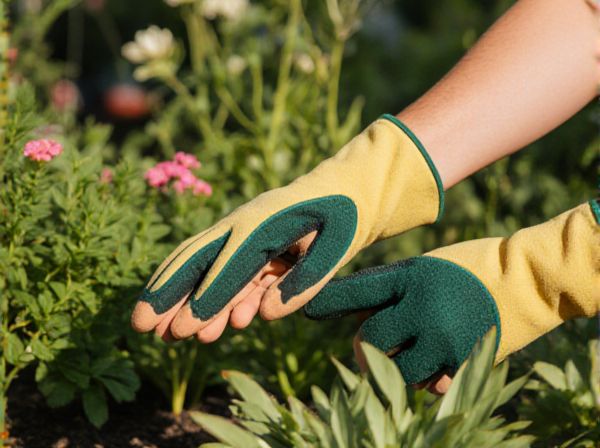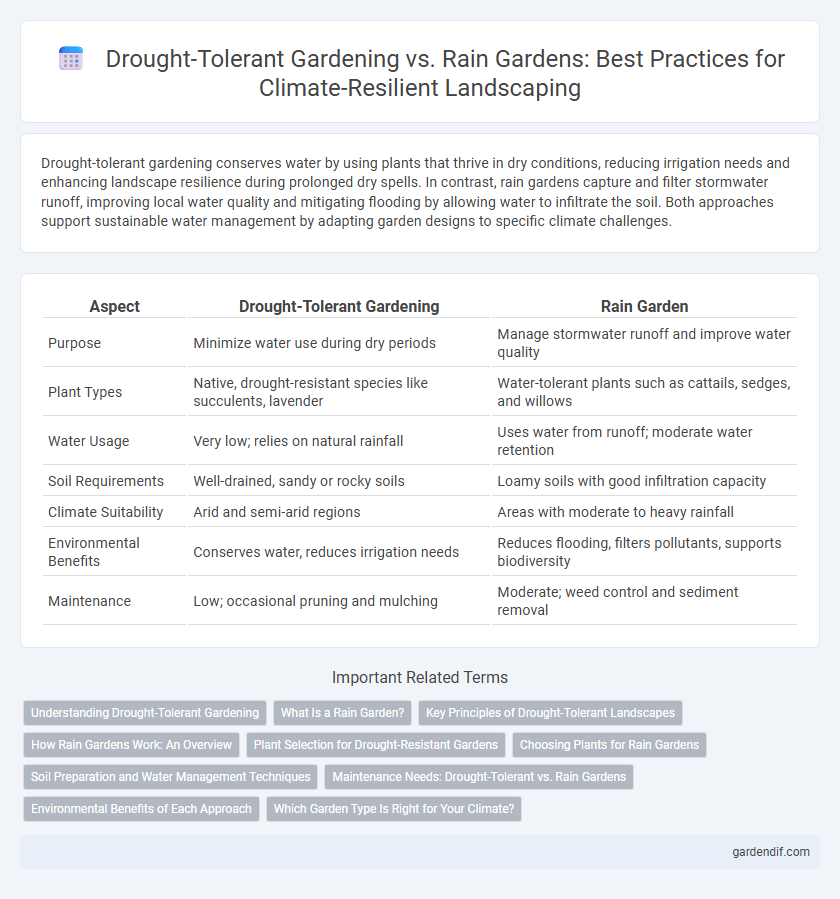
Drought-tolerant gardening vs Rain garden Illustration
Drought-tolerant gardening conserves water by using plants that thrive in dry conditions, reducing irrigation needs and enhancing landscape resilience during prolonged dry spells. In contrast, rain gardens capture and filter stormwater runoff, improving local water quality and mitigating flooding by allowing water to infiltrate the soil. Both approaches support sustainable water management by adapting garden designs to specific climate challenges.
Table of Comparison
| Aspect | Drought-Tolerant Gardening | Rain Garden |
|---|---|---|
| Purpose | Minimize water use during dry periods | Manage stormwater runoff and improve water quality |
| Plant Types | Native, drought-resistant species like succulents, lavender | Water-tolerant plants such as cattails, sedges, and willows |
| Water Usage | Very low; relies on natural rainfall | Uses water from runoff; moderate water retention |
| Soil Requirements | Well-drained, sandy or rocky soils | Loamy soils with good infiltration capacity |
| Climate Suitability | Arid and semi-arid regions | Areas with moderate to heavy rainfall |
| Environmental Benefits | Conserves water, reduces irrigation needs | Reduces flooding, filters pollutants, supports biodiversity |
| Maintenance | Low; occasional pruning and mulching | Moderate; weed control and sediment removal |
Understanding Drought-Tolerant Gardening
Drought-tolerant gardening emphasizes selecting native plants and xerophytes that thrive with minimal water, reducing irrigation needs and conserving resources in arid climates. These gardens improve soil health through mulching and efficient water management techniques like drip irrigation, minimizing water runoff and evaporation. Understanding plant drought resistance and local climate patterns is essential to creating resilient landscapes that maintain ecological balance during prolonged dry periods.
What Is a Rain Garden?
A rain garden is a specially designed depression planted with native vegetation that captures and absorbs rainwater runoff from impervious surfaces such as roofs, driveways, and sidewalks. Unlike drought-tolerant gardening, which conserves water by using plants adapted to dry conditions, rain gardens actively manage stormwater to reduce flooding, prevent erosion, and improve water quality. These gardens promote groundwater recharge and support local ecosystems by filtering pollutants before water reaches streams and rivers.
Key Principles of Drought-Tolerant Landscapes
Drought-tolerant gardening prioritizes the use of native, drought-resistant plants that require minimal water by adapting to local climate and soil conditions. Key principles include selecting deep-rooted plants, improving soil with organic matter to retain moisture, and using efficient irrigation methods like drip systems to minimize water waste. In contrast, rain gardens focus on capturing and infiltrating stormwater runoff to reduce erosion and pollution, often requiring more water management strategies rather than strict drought resistance.
How Rain Gardens Work: An Overview
Rain gardens manage stormwater by capturing and filtering runoff through deep-rooted native plants and engineered soil layers, which absorb excess water and reduce pollutants before it reaches groundwater or nearby waterways. These gardens enhance local biodiversity and improve water quality by mimicking natural hydrological processes, making them an effective solution for urban and suburban areas prone to flooding. In contrast to drought-tolerant gardening that conserves water by using hardy plants, rain gardens actively mitigate stormwater impact while supporting ecosystem health.
Plant Selection for Drought-Resistant Gardens
Drought-tolerant gardening emphasizes selecting native plants and succulents that thrive with minimal water, such as lavender, agave, and sedum, which conserve moisture and withstand prolonged dry periods. Rain gardens prioritize moisture-loving species like cardinal flower and swamp milkweed that absorb and filter rainwater, effectively managing runoff. Choosing the right plants ensures garden resilience by matching species to water availability and local climate conditions.
Choosing Plants for Rain Gardens
Selecting plants for rain gardens involves prioritizing species that thrive in both saturated conditions and periodic dryness, unlike drought-tolerant gardens that favor plants adapted solely to water scarcity. Native species such as sedges, rushes, and specific wildflowers are optimal for rain gardens due to their ability to absorb excess runoff and improve soil infiltration. These plants support stormwater management by filtering pollutants and reducing erosion, making them essential for effective rain garden design.
Soil Preparation and Water Management Techniques
Drought-tolerant gardening emphasizes soil preparation with organic mulch and amendments to improve moisture retention, minimizing irrigation needs by selecting native, drought-resistant plants. Rain gardens require careful soil assessment and amendment with sand or compost to enhance infiltration and prevent runoff, coupled with strategic water management techniques that direct stormwater into depressions for natural absorption. Both approaches prioritize optimizing soil health and water efficiency but differ in their management of water inputs and soil modification to suit specific climatic conditions.
Maintenance Needs: Drought-Tolerant vs. Rain Gardens
Drought-tolerant gardens require minimal irrigation once established, relying on native, resilient plants that thrive in dry conditions, thereby reducing water consumption and routine upkeep. Rain gardens demand periodic maintenance to manage water flow, prevent erosion, and ensure proper drainage, as they capture and filter stormwater runoff. Both gardening approaches promote sustainable landscaping but differ significantly in their irrigation and maintenance requirements.
Environmental Benefits of Each Approach
Drought-tolerant gardening conserves water by utilizing native and hardy plants that thrive with minimal irrigation, reducing the strain on local water resources and lowering carbon emissions from decreased irrigation needs. Rain gardens capture and filter stormwater runoff, improving water quality by reducing pollutants entering waterways and replenishing groundwater supplies. Both approaches enhance biodiversity by providing habitat for native species and supporting resilient ecosystems in varying climate conditions.
Which Garden Type Is Right for Your Climate?
Drought-tolerant gardening thrives in arid and semi-arid climates by using native plants that require minimal water, reducing irrigation needs and conserving resources. Rain gardens are ideal for regions with moderate to heavy rainfall, designed to capture and filter stormwater runoff, improving water quality and preventing erosion. Selecting the right garden depends on your local precipitation patterns, soil type, and water management goals to maximize environmental benefits.
Drought-tolerant gardening vs Rain garden Infographic

 gardendif.com
gardendif.com